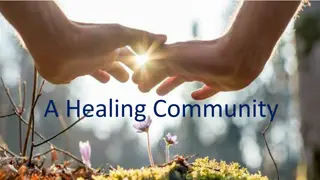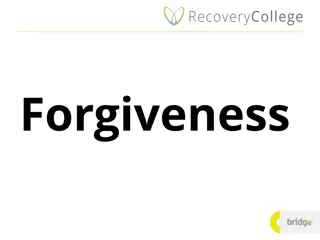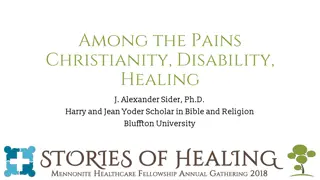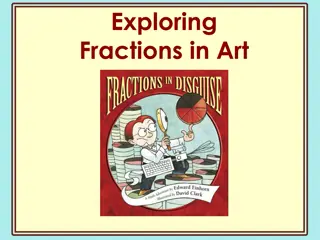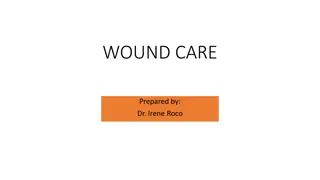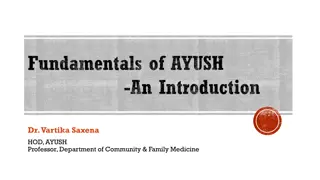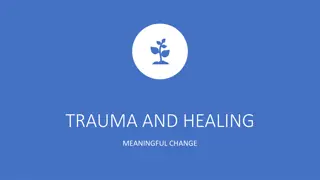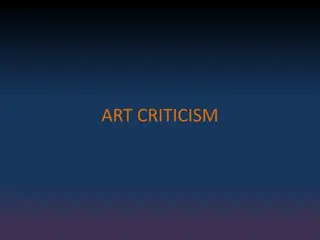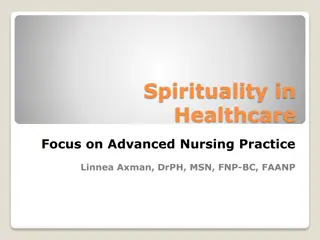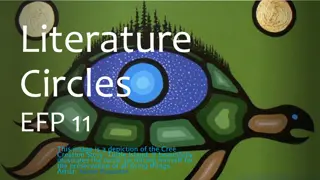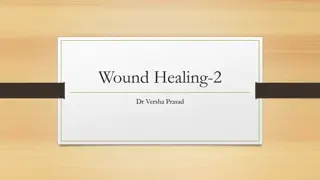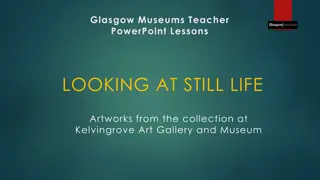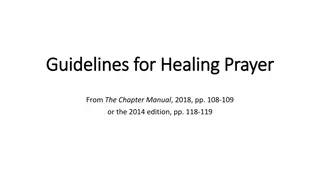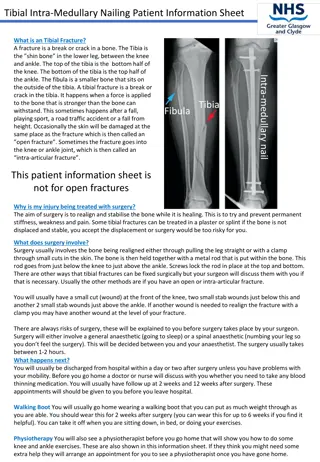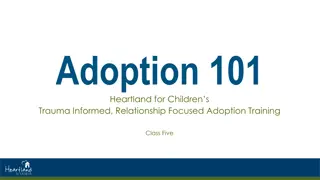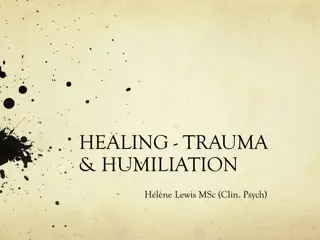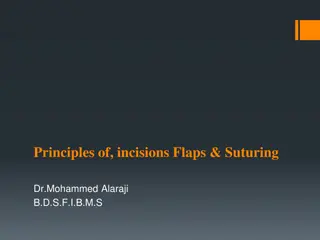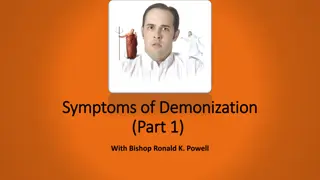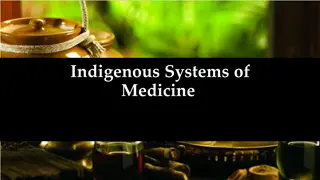Exploring the Healing Art of Aromatherapy: A Comprehensive Guide
Aromatherapy is a holistic healing therapy that utilizes the potent properties of essential oils to promote physical, mental, and emotional well-being. This guide delves into the origins, benefits, and definitions of aromatherapy, showcasing its ability to induce relaxation, reduce stress, enhance energy levels, and restore balance. Discover the art and science behind aromatherapy, a practice deeply rooted in ancient civilizations, offering a natural approach to improving overall health and vitality.
Download Presentation

Please find below an Image/Link to download the presentation.
The content on the website is provided AS IS for your information and personal use only. It may not be sold, licensed, or shared on other websites without obtaining consent from the author. Download presentation by click this link. If you encounter any issues during the download, it is possible that the publisher has removed the file from their server.
E N D
Presentation Transcript
INTRODUCTION TO AROMATHERAPY For S.Y.B.Sc Unit-3 By Asst. Prof. Gurunath Kashivale (HoD Botany) M. S . college, Mumbra
WHAT IS AROMATHERAPY ? Aromatherapy uses pure essential oils to balance the body s equilibrium and to improve mental and physical health. Aromatherapy involves more than fragrance. Plant essential oils have therapeutic powers in addition to beneficial fragrance, and all are antiseptic in different
WHAT IS AROMATHERAPY ? The natural healing art of aromatherapy is an excellent way to promote optimum health and vitality. Aromatherapy can reduce stress, improve sleep and give you more energy. It can improve your complexion, treat an annoying skin itch and eliminate
WHAT IS AROMATHERAPY ? Aromatherapy is a healing therapy that utilises the properties and aromas of essential plant oils. Perhaps the best thing about aromatherapy is that it is so easy and pleasurable to engage in.
Definition of Aromatherapy Aromatherapy conveys the concept of healing with aromatic substances. - Robert Tisserand Aromatherapy is a caring, hands- on therapy which seeks to induce relaxation, to increase energy, to reduce the effects of stress and to restore lost balance to mind, body and soul. - Robert Tisserand
Definition of Aromatherapy Aromatherapy can be defined as the controlled use of essential oils to maintain and promote physical, psychological, and spiritual wellbeing. Gabriel Mojay Aromatherapy is the skilled and controlled use of essential oils for physical and emotional health and well being. - Valerie Cooksley
Definition of Aromatherapy Aromatherapy is derived from two words. Aroma - meaning fragrance or smell and Therapy - meaning treatment. Aromatherapy can be defined as the art and science of utilizing naturally extracted aromatic essences from plants to balance, harmonize and promote the health of body, mind and spirit.
HISTORY OF AROMATHERAPY Aromatherapy was used by the most ancient civilizations and is reputed to be at least 6000 years old. It is widely thought that Aromatherapy began in Egypt. The Egyptians used a method known as infusion to extract the oils from aromatic plants and incense was probably one of the earliest ways of using aromatics.
HISTORY OF AROMATHERAPY Frankincense was burned at sun rise as an offering to the sun god, myrrh was offered to the moon. The Egyptians were experts at embalming using aromatics to help preserve flesh. The Egyptians used to be massaged with fragrant oils after bathing .
HISTORY OF AROMATHERAPY The Greeks continued the use of aromatic oils and used them medicinally and cosmetically. A Greek physician, Pedacius Dioscorides, wrote a book about herbal medicine and for at least 1,200 years as the Western world's standard medical reference. Many of the remedies he mentions are still in use today in Aromatherapy.
HISTORY OF AROMATHERAPY The Romans took much of their medical knowledge from the Greeks and went on to use and improve the ability of aromatics with Rome becoming the bathing capital of the world. After bathing they would be oiled and massaged.
HISTORY OF AROMATHERAPY The Romans started to import new aromatic products from East India and Arabia through the opening up of trade routes. During the crusades the knowledge of aromatic oils and perfumes spread to the Far East and Arabia.
HISTORY OF AROMATHERAPY It was a physician called Avicenna who lived from A.D 980 to A.D. 1037 that is understood to have first used the process known as distillation to distil essence of rose, although it probably took many years to perfect the process. The Arabs also discovered how to distil alcohol around the same time making it possible to produce perfumes without a heavy oily base.
HISTORY OF AROMATHERAPY There is a strong possibility that the ancient Chinese civilizations were using some form of aromatics at the same time as the Egyptians. Shen Nung's Herbal book is the oldest surviving medical book in China which is dated about 2700 B.C. and contains information on over 300 plants.
HISTORY OF AROMATHERAPY The Chinese used aromatic herbs and burned aromatic woods and incense to show respect to God. Traditional Indian medicine known as ayurveda has been practiced for more than 3,000 years and it incorporates aromatic massage as one of its main aspects.
HISTORY OF AROMATHERAPY The North American, Indians also used aromatic oils and produced their own herbal remedies. It wasn't until the 19th century that scientists in Europe and Great Britain began researching the effects of essential oils on bacteria in humans.
Origin of the word Aromatherapie The term aromatherapie was coined by a French chemist called Rene Maurice Gattefosse in 1928. Gattefosse whose family owned a perfumery business, while working in the laboratory one day burned his hand badly. He plunged the injured hand into a container of lavender essential oil and was amazed at how quickly the burn healed without blistering.
What are Essential Oils ? Essential oils occur widely in the plant kingdom and are sometimes referred to as the plants life force or essence or soul . They are minute drops of liquid occurring in glands, glandular hairs, sacs or veins of different plant parts: flowers, leaves, seeds, bark (twigs) and wood (stem), resin (gum), roots, berries or fruit peel of the plant.
What are Essential Oils ? Essential oils give each plant its very specific or unique scent or fragrance. (E.g. as you smell the beautiful fragrance of a rose, you are actually experiencing the joy of essential oils as they are released into the atmosphere) Essential oils droplets are a mixture of complex, organic compounds. When extracted, they are highly concentrated and highly fragrant.
What are Essential Oils ? Essential oils are soluble in oils, fats and pure alcohol, but they are partially or non-soluble in water. Essential oils are also flammable!! (Experiment: Squeeze a lemon or orange rind into a candle flame to see tiny fireworks!) They can be damaged by light, heat, air and moisture. Therefore, we must know how to take good care of our precious essential oils.
Where Essential Oils are found? Flowers neroli, rose Leaves Wood cedarwood, rosewood, sandalwood Fruits bergamot, grapefruit, lemon, orange Berries black pepper, juniper chamomile, lavender, eucalyptus, peppermint
Where Essential Oils are found? Twigs petitgrain Roots angelica, ginger, vetiver Seeds angelica, cardamon, carrot, nutmeg Gum myrrh Whole plant basil, citronella, lemongrass
Where Essential Oils are found? It is interesting to note that different oil can sometimes be extracted from different parts of a particular plant: Angelica seed oil and root oil Cinnamon leaf oil and bark oil
Where Essential Oils are found? Clove leaf oil and bud oil Orange tree: blossom neroli; fruit orange; leaves and twigs petitgrain
Main constituents of essential oils In general, essential oils consist of chemical compounds which have hydrogen, carbon and oxygen as their building blocks. These can be subdivided into two groups: Hydrocarbons made up almost exclusively of terpenes. Oxygenated compounds mainly alcohols, aldehydes, esters, ketones, oxides and phenols.
Main constituents of essential oils Acids, lactones, sulphur and nitrogen compounds are sometimes also present. True essential oils may only be obtained by the methods of distillation or expression that preserve the life-giving vital essence of the plant.
Production Of Essential Oils An oil such as the highly expensive rose oil yields just 0.01% essential oil. No wonder it is so costly! Rose oil Bulgarian takes approximately 4,000 pounds of hand-picked flower petals to make 1 pound of oil, making it one of the most expensive oils that can be purchased!
Production Of Essential Oils 60,000 rose blooms are required to produce 1 ounce of rose oil. 220 pounds of Lavender plant to produce 7 pounds of oil. 400 kg of Thyme would produce 1kg of essential oil. 6,000 kg of Orange blossoms to produce 1kg of Neroli.
Modes of action It is important to recognize that essential oils have three distinct modes of action with regard to how they inter-relate with the human body: Pharmacological Physiological Psychological
Modes of action The pharmacological effect is concerned with the chemical changes which take place when an essential oil enters the bloodstream and reacts with the hormones and enzymes, etc. The physiological mode is concerned with the way in which an essential oil affects the systems of the body, whether they are sedated or stimulated, etc.
Modes of action The psychological effect takes place when an essence is inhaled, and an individual responds to its odor. With relation to the first two points, Aromatherapy has a great deal in common with the tradition of medical herbalism or phytotherapy. In fact, these two forms of therapy are not
What is not Aromatherapy? The practice of using essences that did not originate from an aromatic plant that was once alive is not Aromatherapy. 95% of the products sold as aromatherapy are counterfeits pseudo-aromatherapy. Their aromas derive from synthetic scents, and they offer no therapeutic value whatsoever.
What is not Aromatherapy? True Aromatherapy never uses synthetic aromatic substances. Pseudo-aromatherapy relies on synthetic petrochemicals that merely smell but have no healing qualities. Simply having an aroma doesn t make something Aromatherapy.
Methods of application Aromatic ointment Cleaning Creams / Lotions / Gels Compresses Facial steam First aid Gargles and Mouthwashes
Methods of application Inhalation / Diffusion / Environmental fragrancing / Vaporization Candle Car Aromatherapy diffuser Ceramic / Clay / Glass / Metal Vaporizer or Burner Electric pottery diffuser
Methods of application Handkerchief Humidifier Lamp / Light-bulb ring Nebulizer (electronic glass diffuser) Room spray / Mist spray / Atomizer Tissue paper
Methods of application Ultrasonic Aromatherapy diffuser Water bowl Massage Natural perfumes Neat application Powders (rice or corn flour - for foot and body)
How can you benefit from essential oils? Each essential oil has unique properties which can be used to relieve stress, stimulate body processes such as elimination or circulation, ease painful muscular tensions and generally give the recipient a heightened feeling of well-being. People have described having calming, cheering, soothing or uplifting experiences.
How can you benefit from essential oils? Emotion based benefits Anxiety Depression Fear Frustration Grief Hopelessness Hysteria Insomnia
How can you benefit from essential oils? Emotion based benefits Irritability Lack of Concentration Moodiness Nervous Tension Panic Attacks Poor Memory Sadness Worry






